In a world where Google tries to make the SERP a safer place for its users, it seems SEO’s are exploring any opportunity in order to squeeze more visibility. Not long ago Google decided to remove Authorship photo’s from the results page in order to create a homogeneous and uniform look. One official explanation was given by John Mueller on a post from his Google+ account:
We’ve been doing lots of work to clean up the visual design of our search results, in particular creating a better mobile experience and a more consistent design across devices.
In other words, Google wants to improve the user experience and clean its SERPs of any cluttering visual designs. We can also presume that they took this action after a lot of testing which provided the information that users can live without the authorship pictures. But after the Google+ photos being deleted from the SERPs, based on the same cluttered removal concept, I would expect a removal of the rich snippets from the search results.
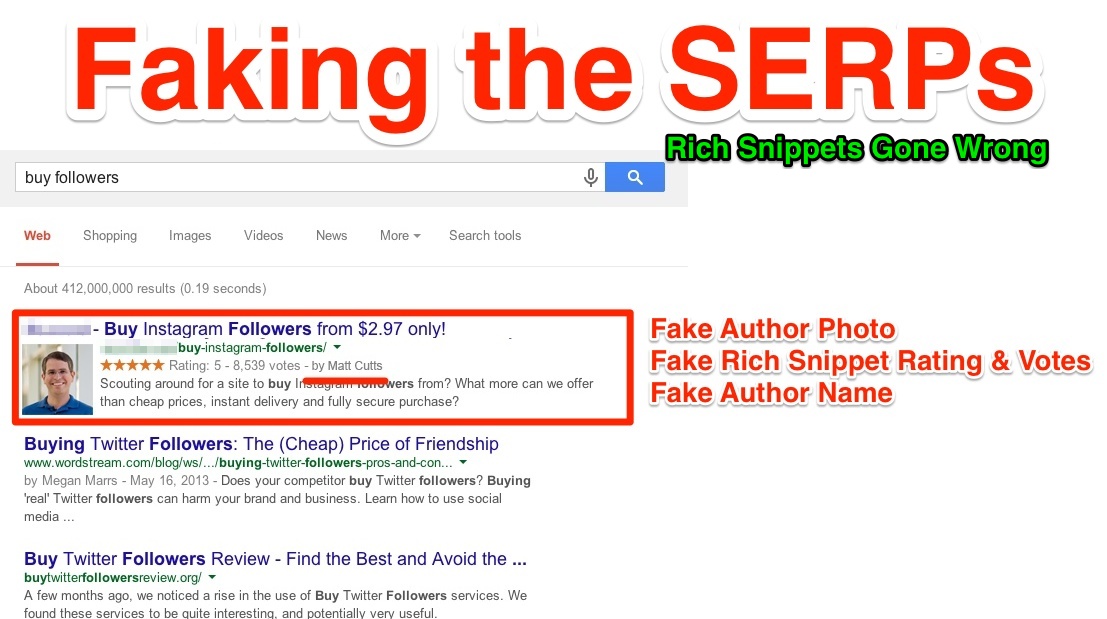
In the intricate world of web optimization, the web owner knows every piece of content and every corner of its website. The Rich snippets were implemented by Google to help users identify the websites and their content quicklier by displaying pieces of content in search results called snippets. It gives the user a convenient snippet of information based on the content that’s on the site you’re about to access if you decide to click on the result. They immediately can spot if the content is relevant to their query or not. If they happen to search for a product or a place, they can receive additional information regarding reviews and ratings. If they search for a certain person, you’ll get snippets that would help you differentiate results. Its initial intent was to change the results we receive, so we can decide faster on what’s relevant to our search. They even stated in a blog post on Google Webmaster Central Blog that these additional pieces of information are meant as an incentive:
It’s a simple change to the display of search results, yet our experiments have shown that users find the new data valuable — if they see useful and relevant information from the page, they are more likely to click through.
Rich Snippets or Author Photos Removal – Which is More Important for the User?
While Google stated on numerous occasions that they want to improve the search experience for their users, we ponder on their latest decision. Right now you can pick out from nine types of rich snippets that can be annexed to your website in search results. That means you can juggle between authorship, reviews, products, businesses and organizations, recipes, events, music, and people. Every piece of structured data that you can add to your rich snippets creates a more detailed result to the listing. But is every bit of information helping the user, as Google wants ? We will try to explain to you can some rich snippets are exploited in order to provide a false sense of security.
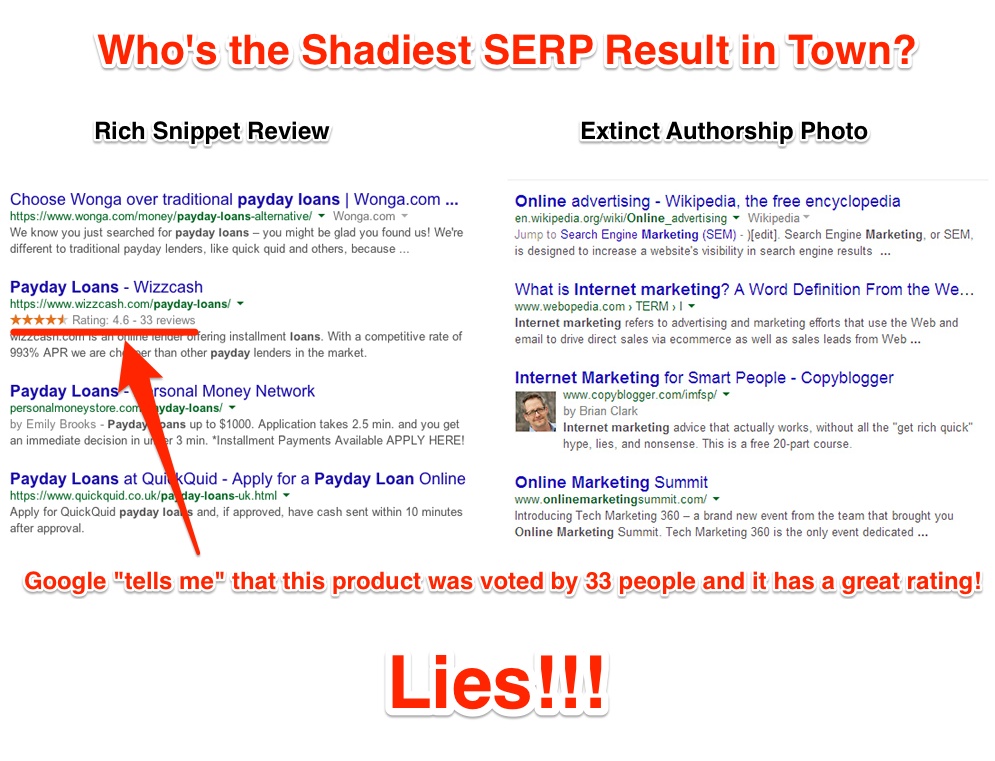
In the image above you have an example of a review rich snippet for the “payday loans” search query. Basically, Google shows me that this result has a rating of 4.6 from 33 reviews. This “tells me” that this product is highly praised by 33 clients. Because Google displays all these rating scores and stars, people take them for granted. They are merely a bunch of numbers placed by the website owner, that don’t have any correlation with a rating system from within the website. It can very well be 10 000 reviews instead of 33. On the right side of the screenshot, you have a Google Authorship photo, so you can see by comparison which influences the user experience more – a simple photo of a person or a rating that states the quality of a product or service. I can’t help but wonder if a simple Google+ photo can be more cluttering than some dubious numbers annexed to a search result.
Here’s a breakdown on a couple of reasons that will show you why rich snippets, as they are now, are poisoning the whole search results :
- Because they are a simple on page factor that allows you to alter the SERPs visually.
- Because they induce fake trust to the users. The searcher will think that these reviews are real and that they should be taken into consideration when considering which search result will aid him the most.
- “X” people have voted for the site. But this is a random number added by the owner of the site.
- In my opinion, the fake rich snippets should be focused more, as they don’t give valid and pertinent information to the user.
Examples of Abused Rich Snippets Reviews
As Google tries to offer their users pertinent results to their queries with their latest updates ( Panda 4.0 and Payday Loans 2.0 ), there is a new trend on the rise – the rich snippet abuse. Humans prove their adaptability once more as they transform a thing that was designed to help users comprehend the content of a page displayed in search result into a method to influence user perception and increase CTR.
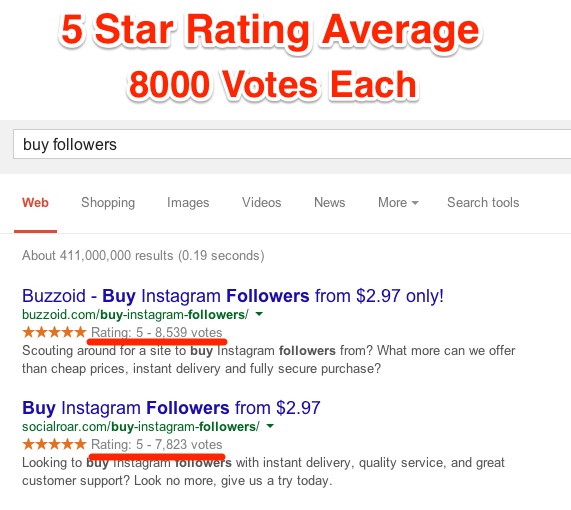
For example, we’ve got the “buy followers” search phrase. If you’re going to look on Google for this specific keyword, you’ll find two sites battling each other at the top of the SERPs with perfect ratings and hordes of votes. It’s a very trustworthy factor that can be taken into consideration, as they are the only sites that were given 5 stars for their services. But if you were to closely inspect the websites you would notice that those numbers are hidden in mere meta items. There is no voting system in place anywhere on the websites.
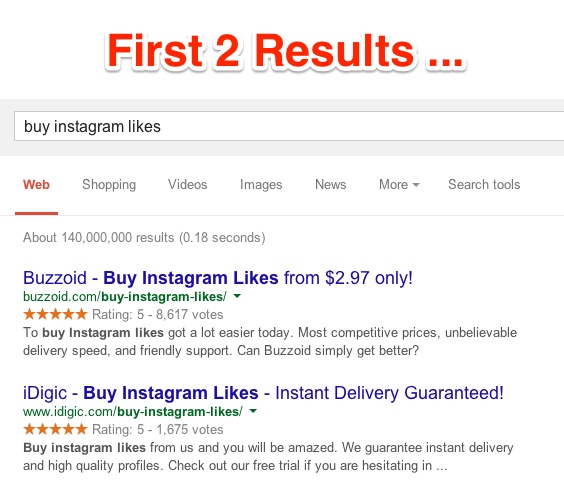
We have another example of rich snippet abuse in the picture above. It’s incredible how easy it is to overlook the truthfulness of this piece of information. We tend to take the information for granted and proceed to click on the website. And we do this because we believe Google has our best interest at heart. Because we believe that those reviews and stars are validated and placed there by Google. The reasons why these types of rich snippets are a SERP bad omen:
- They attract the user’s attention to the fake numbers
- They improve the CTR for the site in an unnatural manner compared to the others.
- They have SERP landscape that was not gained but edited by the user.
- They can influence the click on the SERPs

If you want to see for yourself these types of rich snippet exploits in action, you should type in Google search phrases like “buy instagram likes” or “buy instagram followers”. The trick behind these false review rich snippets is the fact that they are just numbers hidden in the code of the site. Moreover, what’s worth mentioning is the fact that you can put any number there. You can easily set yourself a rating of 5 out of 5 with 5 000 reviews. In the image above you have a self-explanatory example of the fact that it doesn’t require a lot of time and effort to create a godlike review rich snippet. In this example, the webmaster set a rating value of 5 and a rating count of 1675. But like I’ve said before, you can change those numbers as your heart pleases.
Rich Snippets Seen in the Wild
Even though we’ve tried to make a pretty solid case against rich snippets and their relevance to the user, I’m also going to show you the perfect example of a valuable rich snippet. That way, you’ll see how it looks in the SERPs and why it’s so hard to differentiate between the fake ones and the genuine ones.
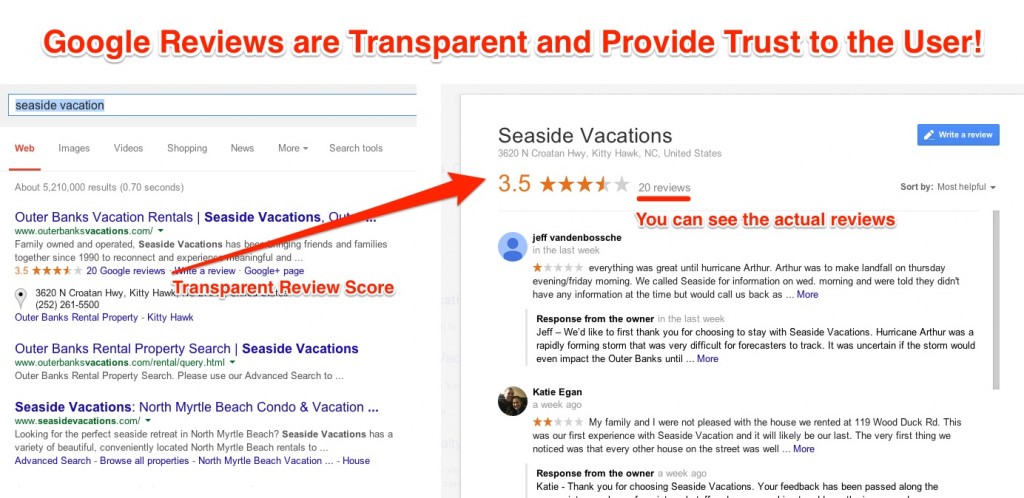
As you can see from the picture above, this is a case in which the site uses a snippet that contains data from Google+ reviews and ratings! It displays a true rating in SERPs that was given by users on Google+. This is the way to go with rich snippets. To have transparent reviews in the open for everyone to access the data and see who validated the company. Another beneficial thing is the fact that you can browse through the reviews and see who wrote the review and how many stars they awarded. The Google+ reviews offer full transparency regarding the user evaluations. In our example screenshot, the searcher can easily access reviews and ratings regarding “seaside vacations”. These types of rich snippets add value to the search result and help the user. I think the placement of rich snippets that use accessible and transparent data like Google+ reviews is fruitful for both the searcher and the webmaster.
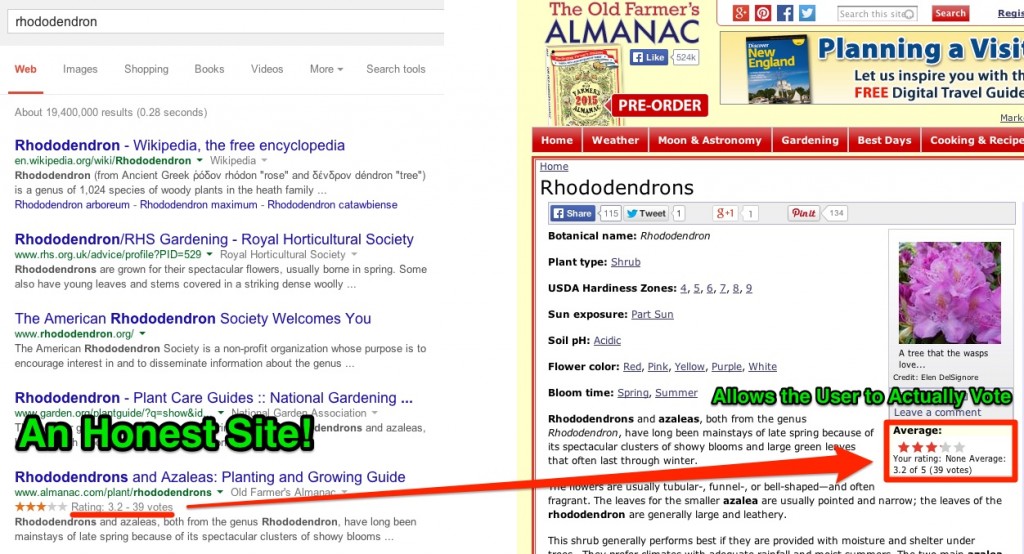
I present you another perfect example of a honest review rich snippet seen in the wild. It appears on the “rhododendrons” keyword. You can see it has a fairly good rating coming from 39 votes, displayed in the search results. But in contrast to the abused rich snippets presented earlier, this rich snippet data corresponds with the data from the site. As you can see, the website has a voting mechanism in place that allows users to actually vote. That’s the most important part. In many cases of abused rich snippet cases, webmasters used information that couldn’t be correlated with anything from the website. And some of them were penalized accordingly.
Rich Snippet Google Penalty
While you might think this rich snippet abuse passed Google’s sharp eyes, they already took action against websites that had irrelevant ratings as rich snippets. So it’s worth mentioning that they are penalizing websites that use rich snippets in shady ways. This type of warning appeared for the first time on the Google Webmaster Central forum. A confused user inquired details about the warning and the issues that Google had with his website. He received a penalty regarding a misuse of markups. From what it seemed, it doesn’t matter if the webmaster had any spam intent or if it’s only a mistake. The manual action taken against his website came with the following message:
Markup on some pages on this site appears to use techniques such as marking up content that is invisible to users, marking up irrelevant or misleading content, and/or other manipulative behavior that violates Google’s Rich Snippet Quality guidelines
The mystery was later solved by another user that posted a quote from Google’s rich snippet support resource which was validated by Google’s John Mueller.
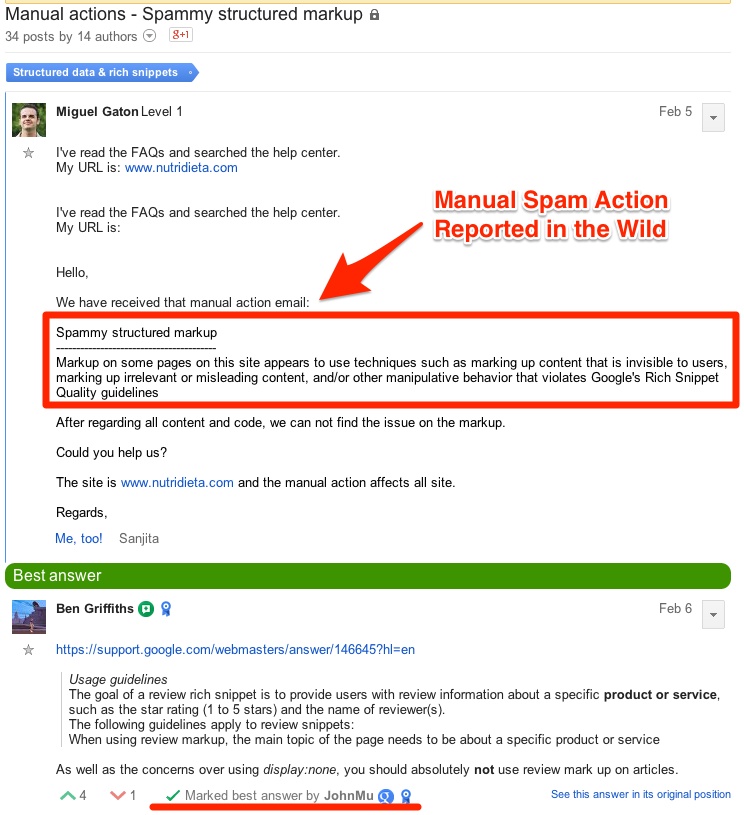
In another case of rich snippet penalty, a user was baffled by the same manual penalty. Later, the same user, who was affected by the penalty, answered his own dilemma with a quote from Google guidelines: “In general, Google won’t display any content in rich snippets that is not visible to human user”. This answer was marked as “best answer by Google’s John Mueller. This type of manual action seems to be targeting sites that use rich snippets in a faulty way, regardless of their intent. This penalty applies to all types of rich snippets varying from ratings on sites that don’t have a rating system to reviews without a real source and misplaced authorship.
This later addition to the manual action palette of penalties seems to be necessary but not very effective. If you’re not really sure if your rich snippets are within Google’s guidelines you can check the information from the rich snippet help area.
3 Ways a Black Hat Could Easily Abuse the Rich Snippets
Rich snippets weren’t really a priority for black hat SEO’s in the past, but somehow they’ve managed to turn them into exploits. In this section of the article we’re going to cover a couple of ways in which black hat SEO’s are abusing rich snippets in order to increase the click-through rate. It won’t be long till we’re going to see these types of rich snippet abuse on a daily basis. These are 3 rich snippet exploits that are being used in order to trick users into clicking:
1. Fake an Author Profile Photo – Adding the profile photo of a renowned influencer can be the best incentive for users to click on a link. This type of cunning fake rich snippet can be the most fruitful back hat scheme out of these three as it is visually stimulating and easy to spot.
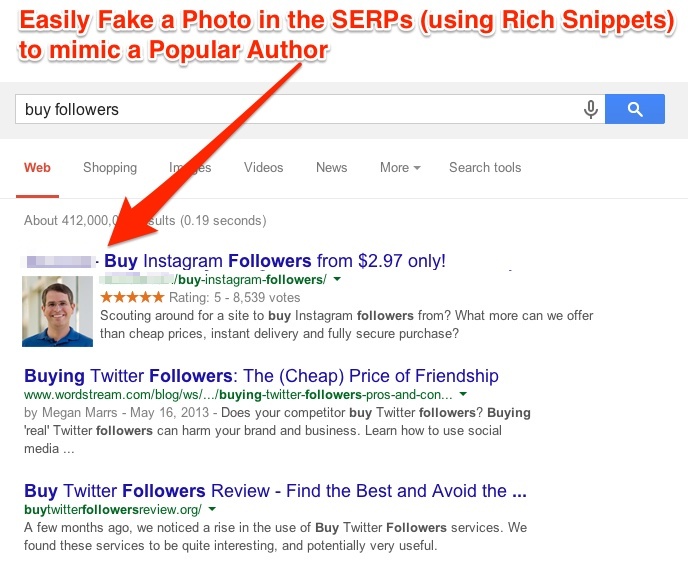
2. Fake a Popular Author Name – Similar with the author profile photo trick is the fake author name. The black hat SEO’s usually target very famous people in order to create enthusiasm among the searchers. In the screenshot provided below you can see that this fake name technique is coupled with the fake author profile photo one. That way, it strengthens the credibility.
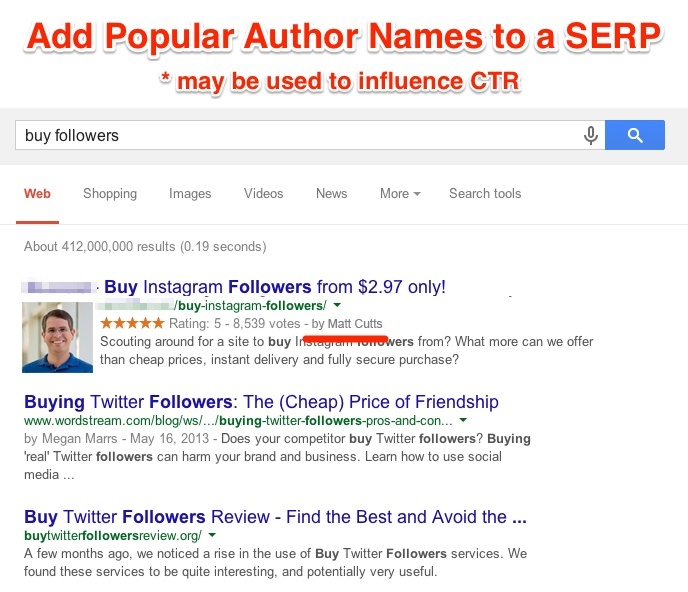
3. Fake a Video Preview – As you can see from the picture below, one can also influence users by annexing a fake video thumb in the rich snippets. The video doesn’t exist on the site and misleads the users into thinking that there is video content on the site. In my example, you can see a fake video snippet placed purely to incite users to focus on that result. You can also read about the Marks and Spencer’s fake video preview situation, where they’ve tried to influence users by creating videos of the product stills. Those were then highlighted as rich snippets.
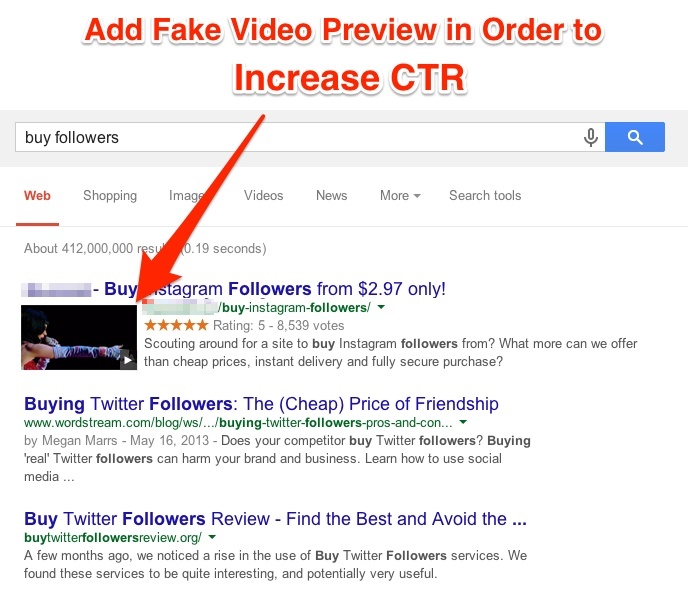
What is Schema.org good for then if the Reviews are All Fake ?
From the looks of it, it seems like some of the good intentions Google had with rich snippets are already turned into abuses. Even though the rich snippet exploits are a real scary issue, schema.org can be very helpful. Despite the fake reviews, there are types of snippets that can provide useful and quick information to the user ( the way rich snippets were intended ).
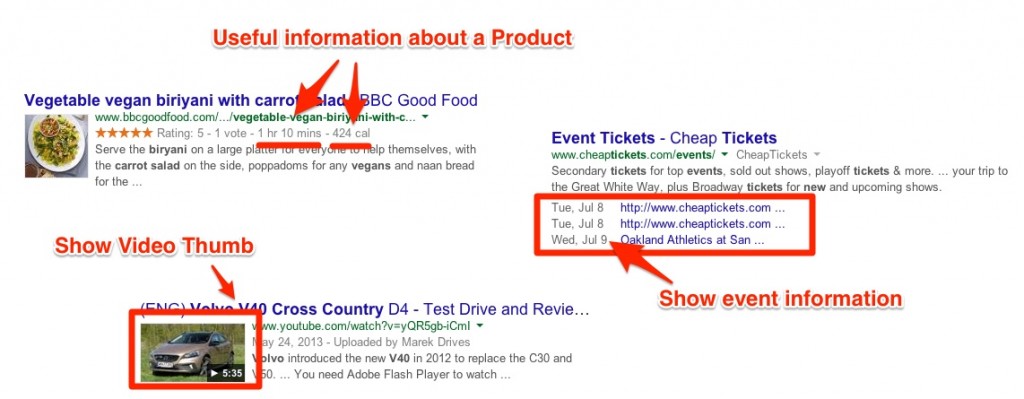
You can see from the picture above some excellent examples of rich snippets:
- You can provide useful data about a product. For example, if you have a cooking site, you can place information about the cooking time and the calories for a certain recipe.
- Show video thumbs from the video content that you have on the pages. You can see from the image, the page is about a car. And it also provides a video thumb to show the user that it will find an explanatory video about the car inside the page. It shows the user the type of content he can expect if he clicks on the link.
- Display information regarding events. Another useful rich snippet information that you can provide to the searcher are the locations and dates of upcoming events.
These examples of rich snippets add value to the user searching for information, and it differentiates your site from the rest of the pack in the SERPs. It provides them with bits and pieces of information that are also contained on the page, in more details. They don’t try to mislead or manipulate the user in any sort of way, and it actually matches the content.
Conclusion
As a final word, I believe that Rich Snippets Reviews, even if they prove their relevance in some occasions, are already a real source of abuse and should be removed from the SERPs. The only relevant and transparent review rich snippets are provided by Google+. They decided to remove the authorship photos because it added too much clutter to the user experience, but it seems that these untruthful rich snippets may pose a real threat to the integrity of the search results. This type of structured data can be transformed from a piece of useful information to a Shady SEO tactic. It proves to be more useful for the SEO than for the searcher.
What’s your take on the rich snippet abuse ? If you have other examples of rich snippet abuse you can share them through the comment section below.

 Site Explorer
Site Explorer Keyword tool
Keyword tool Google Algorithm Changes
Google Algorithm Changes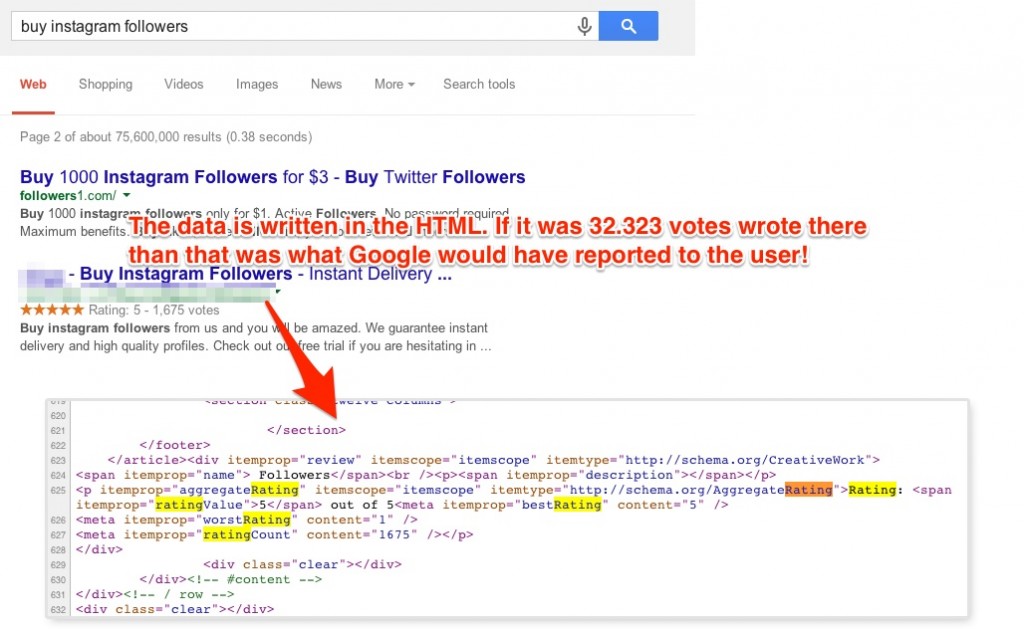


Surely if you’re looking to buy social followers, you should a) be expecting SERP manipulation and b) see it as a good thing as it shows expertise in what you are trying to do?
that is an interesting point of view. problem is the buyers won’t even realize that those are fake 🙂
Complaining to Google you bought fake followers is like complaining to the police your drug dealer sold you bad coke 🙂
The ugly thing is you can’t decide clearly about the truthfulness of rating data if you only look into the page’s HTML source: whether the faked data was just “hardcoded” into HTML directly or the data is native and the HTML file was generated from a PHP file and rating values were queried and putted into it from a database.
In this post: https://plus.google.com/109610513557156403159/posts/8kRnXzToYbg was discussed an issue about misusing structured markup, which caused penalty. And i realized, that some often used WordPress rating plugins markup visual rating results with display:none (this markup is kinda AJAX caused or so…). Penalty cause is pretty clear in such cases.
It is true, there are some folks troll the streets, who can turn any good thing into bad, and the impact will be: getting rid in general of visible rich snippets in SERP, rating as the first, and, if not, justifying of algorithms to penalize possible misuse, with usual collateral damage.
But structured data, whether visible in SERP as rich snippets or not, brings benefits nevertheless, cause, correctly implemented, it makes the content better machine-readable and understandable. My conclusion, as always: don’t misuse and inspect in detail any third part extension’s code you use to avoid such penalty-risky things like display:none.
tks for the comment Evgeniy. I agree that they are good as a concept. But why not replace them with G+ Reviews for example. They are transparent and third party validated. Not On-page metrics that can easily be altered. And about the photos in the SERPs that is another thing that should be looked at more closely.
It seems though that the number of rich snippets in the SERPs are lower and lower.
Hi! Nice Article, I Have a Question, how can Notice to Google about that bad practices, I know a case!
Thank you very much! Greetings from Colombia 😀
you could open a thread on for example https://productforums.google.com/forum/#!forum/en or do a spam report here if it is the case https://support.google.com/mail/answer/190737?hl=en
I know this post is a couple of months old but it seems the algorithm is getting better and better determining when to display rich snippets.
By now the authorship photos and names have been completely removed. Authorship wasn’t really thought through as anybody could use any picture and any name… 😀 You are asking for trouble with that kind of freedom.
Star ratings for reviews are also a lot harder to get. Seems like you need a certain level of “authority” to have them displayed. E.g. you can see them implemented in the Structured Data Checker and with site: but it doesn’t show up for real search results.
You guys are just friggin awesome with your indept posts.
Greetings from Innsbruck,
Alex
tks for the comment Alexander. They still show up in the SERPs, rarely but they do and they are still abused. When this was written the search engine already filtered out a lot of rich sniappets but the weird thing is that some of the results still could be abused.
Authorship in my humble opinion was only a test applied to the SEO crowd and Tech crowd which are avid for these kind of things. Problem is it did not get traction in other areas. It was really hard even with all the pushing from G to convince SMBs to have Expert Authors on their field. And here I mean large scale. Not 1 out of 10 SMBs. These would have been a success if 9 out 10 SMBs would apply the authorship thing.
Either- way they tested something for a couple of years. Imagine how many smaller tests they are running daily 🙂
I agree, from an SEO perspective it looks like they removed an important feature but looking at the big picture almost nobody was using it…
Looking forward to another indepth article 😉
😉 stay tuned. coming soon.
Thanks for the in-depth article Razvan.
So, I am still trying to figure out..: Does Google currently display reviews rich snippets or not?
I have got a number of authentic reviews displaying on my website, generated by a third party website, and I have marked these up using the data highlighter using Google Webmaster tools. I did this about 3-4 weeks ago, but haven’t noticed them ever appear in the SERP. Should I expect that they might show up someday soon (despite the views you have expressed!), or was I just wasting my time with the markup?
Many thanks
Sunil
I think there is low change you will get those rich snippets to appear. rarely they appear nowadays and as I shown above in the article they are used by a lot of people incorrectly.
Thanks for your reply Razvan.
It’s a shame for people that are doing the right thing, but I guess, it was just too open for abuse!
Regards
Sunil
Google mentioned “If the markup contains a single review, the author’s name needs to be a valid name. For example, “50% off until Saturday” is not a valid name for a reviewer.” in structured data guidline page.
Could you tell me what is the “single review”?
If just the Author able to review its article then it will not be an honest rating, what is the purpose of the single review then?
Also I have seen some pages with just single review and I am not able to rate the page! just author rate it with his/her name.
As i see, Google still display reviews rich snippets currently, but only from large, very large sites from which they get the big money.
Everything they do and act is for money if you fooled can’t or you don’t want to understand!
In my wordpress site I had reviews with Rich snippets plugin, everything was transparent, people could interact with the site and reviews were showed, no hidden content at all, not fake reviews, becides there were only a few reviews in some pages only.
Despite that after just a few days i noticed that the stars dissapeared from search results, not only from mine but from most sites, and a week later i noticed in search console that i got hit by the manual penalty, so i used the only choice i had, removed all reviews and fill a reconsideration request.
The good thing is that my SERPs not only were completely unaffected but got better, and the second good thing is that my CTR is the same and for some keywords even better!!
So all these speculations about lost SERPs in cases of rich snippets penalty and about higher CTR with rich snippets on are nothing but myths.
I cannot know what will happen to my SERPs later, i hope nothing, because there have been more that 2 weeks since the penalty.
Pursuant to “Rich Snippets Seen in the Wild”, google reviews are not allowed anymore. You can only have review snippets that come from your site.
Google made another change (again) in September 2016.
Hi,
I suspect my site was hit with this and it is an algorithmic one (since there was no message in webmaster tools). The reason why I came to this conclusion is that Google removed all my star ratings from SERPs and threw me to 5th page from the first position.
I have removed all rich snippets and breadcrumbs from the site, can you please let me know how should I let Google know that I have made the changes since there is no reconsideration request form available?
My website is the same as yours. The rating disappeared witbout any notification.
Funny how are all this cheap niche sites doing that, copy and pasting, also all this “seo” and ranking is getting so much harder. Big brands outrank you in 3 seconds, easily.
Back in 2016 it took me 1 month to rank now 8 months to 1.2 years. I bet in 2023 it will be 10x harder. It’s time to move on and do something else.
Ty for this information. I am seeing web design companies using the review snippet as a way to display fake reviews in the SERPS.
Very frustrating to see. How long does it take for Google to catch on to this?
Do you recommend a way to display your verified Google reviews in the snippets/serps?
Using verified and legitimate comments and reviews system with RECAPTCHA will be a great way to gain aggregating stars in Google serp
To get the star ratings on your Google Search results listings you need to use something called “schema.org markup”, “structured data” or “microdata”. Basically, this is a standard for how you label data on your website so that browsers and bots like Google can interpret it and know what it represents.